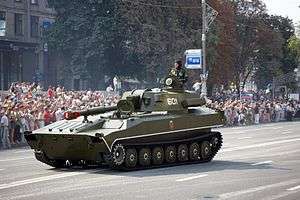Kharkiv Tractor Plant
 Kharkiv Tractor Plant logo | |
|
Main entrance to Kharkiv Tractor Plant | |
Native name | Харківський тракторний завод |
|---|---|
| Public company | |
| Industry | industrial vehicle production |
| Founded | 1 October 1931 |
| Headquarters | Ukraine, Kharkiv Oblast |
| Products | Tractors |
Number of employees | 3000 |
| Website | KhTZ official website |
Kharkiv Tractor Plant (Ukrainian: Харківський тракторний завод, Kharkivskyi Traktornyi Zavod, abbreviated ХТЗ, KhTZ) is a tractor plant in Ukrainan city of Kharkiv.
History
Building of the Plant in the First Five Year Plan
The Kharkiv Tractor Plant was one of two major tractor plants (the other at Chelyabinsk) built as one of 'the giants of the first five-year plan' - the Sergo Ordzhonikidze Kharkiv Tractor Works. In the 1920s tractors had been seen as a way of improving agricultural production and persuading the peasantry of the merits of the regime and voluntary collectivisation. But it was said that in the Spring of 1929 only 5 were functioning in the Ukraine where a huge amount of agricultural production took place.
Tractor production was therefore an important part of the new five-year plan. But with policies of forced collectivisation and 'the liquidation of the kulaks as a class', tractors became even more important symbolically and practically - to increase output and to compensate for the widespread loss of horses which were slaughtered in peasant resistance to forced collectivisation.
The building of the Kharkiv plant began in 1930 in fields outside of the city. The aim was a plant that would eventually make almost everything needed for a tractor from the iron and steel to the most complex parts. Building involved some 10,000 workers, 2000 horses, 90 million bricks, 160,000 tons of steel and 100,000 tons of iron. The building workers were former peasants escaping collectivisation, demobilised Red Army soldiers and some members of the Komsomolsk. They lived in primitive conditions in some 1500 wooden barracks.
Bricks were made on site with kilns constructed for the purpose and using local clay - some of which was dug out of the foundations. Materials were often hauled by hand and sleds. There were few machines - 24 powered concrete mixers and 4 gravel crushers. Building techniques too often had to be learned on site by workers who in the past might only have built wooden peasant houses with their brick stoves.
Workers were encouraged by the propaganda of the time which praised heroes like the bricklayer Arkady Mikunis who was said to have laid 12,000 bricks in a day in a contrived example of fast work or a young woman, Varva Shmel, who went from being a peasant girl to a mechanic. The plant had its own newspaper (Temp) and agitators. Forms of socialist competition were the used and slackers could be punished by denunciation on wall newspapers.
The shell of the plant was competed by July 1931. Some five hundred specially selected workers were sent on special training courses in Moscow and Leningrad to learn how to use the new imported equipment. The first test tractors were produced in August and full production begun in October 1931. The opening of the plant was a major propaganda event both in the Ukraine and the wider USSR.
The Factory in the 1930s
The plant first built SKhTZ-30/15 wheel-type tractors. The first director of the plant was Svistun. The Kharkiv Tractor Works was awarded the Order of Lenin in 1932. In 1937 the plant shifted to the production of SKhTZ-NATI crawler vehicles.
Inevitably the bosses of the plant and some of its workers were caught up in the purges of the later 1930s. These included the party agitator Boris Bibikov who was shot as a Trotskyite but who its seems had sympathised with Kirov. Part of his story is told by his grandson, Owen Matthews, in an English language family memoir.[1] Amongst the accusations made in these cases were various forms of sabotage in the plant including breaking machines, delaying the payment of wages etc. To the extent that these were genuine problems it seems likely that they were actually explained by the inexperience of quickly trained workers using expensive machinery and the various bureaucratic hiccups of the day.
Wartime Evacuation
During the World War 2 the plant’s equipment was evacuated to Stalingrad and then to Rubtsovsk, in the Altai Krai in Siberi where it was as the basis of the M. I. Kalinin Altai Tractor Plant, which began producing as early as 1942. The original Kharkiv plant itself was almost completely destroyed during the war. When Kharkiv was liberated in 1943, work immediately began on rebuilding the factory.
Soviet Era to 1991
From the 1949 the plant made the DT-54 diesel tractor, the main ploughing tractor used in agriculture until 1962. From 1954 to 1972 the plant also produced a wheel-type row-crop tractor with a tractive force of 0.6 tons-force. In 1962 the T-74 ploughing tractor went into production. The plant produced its millionth tractor in 1967. During the ninth five-year plan (1971–75) the T-150K was introduced. The Soviet era factory was awarded the Order of the Red Banner of Labour in 1948, another Order of Lenin in 1967, and the Order of Georgi Dimitrov in 1975.
Models
Historical
- SKhTZ 15-30 tractor (1930-1950)
- SKhTZ-NATI tractor (1937-1952)
- DT-54 tractor (1949-1979)
- KhTZ-7 tractor (1950-1956)
- KhTZ-12 tractor (1952)
- DT-14 tractor (1955-1959)
- DT-20 tractor (1958-1969)
- T-75 tractor (1960-1962)
- T-16 tractor (1961-1967)
- T-74 tractor (1962-1983)
- T-125 tractor (1962-1967)
- T-25 tractor (1966-1972)
Currently produced
- MT-LB armoured tracked vehicle (since 1966)
- T-150K tractor (since 1971)
- T-150 tractor (since 1974)
- T-012 tractor (since 1990)
- KhTZ-2511 tractor (since 1994)
- KhTZ-5020 tractor (since 1994)
- KhTZ-161 tractor (since 1997)
- KhTZ-170 tractor (since 1997)
- KhTZ-181 tractor (since 1997)
- KhTZ-200 tractor (since 1997)
- KhTZ-308/5 combine harvester (since 2016)
Gallery
 First serial SKhTZ 15-30
First serial SKhTZ 15-30 SKhTZ-NATI
SKhTZ-NATI KhTZ T-16
KhTZ T-16- T-150K
 T-74
T-74- MT-LB
 2S1 Hvozdyka
2S1 Hvozdyka
References
- ↑ O.Matthews, Stalin's Children. Three Generations of Love and War, London: Bloomsbury, 2008
External links
| Wikimedia Commons has media related to KhTZ vehicles. |
.jpg)